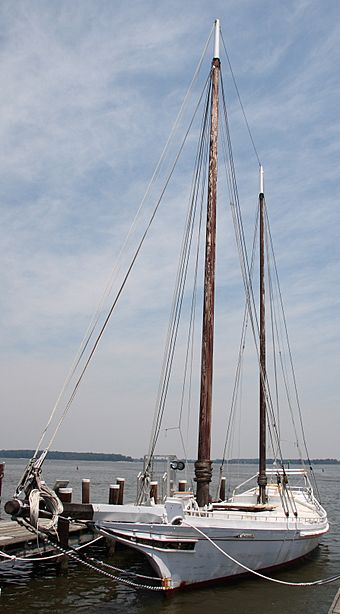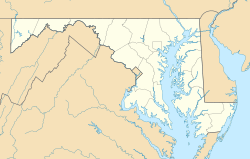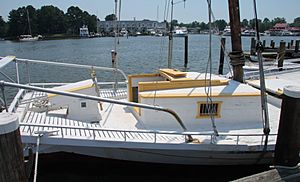Edna E. Lockwood facts for kids
|
Edna E. Lockwood (Chesapeake Bay bugeye)
|
|
 |
|
| Location | St. Michaels, Maryland |
|---|---|
| Built | 1889 |
| Architect | John B. Harrison |
| NRHP reference No. | 86000258 |
Quick facts for kids Significant dates |
|
| Added to NRHP | February 13, 1986 |
| Designated NHL | April 19, 1994 |
The Edna E. Lockwood is a special type of boat called a Chesapeake Bay bugeye. It is the very last working oyster boat of its kind. You can find her at the Chesapeake Bay Maritime Museum in Saint Michaels, Maryland.
This amazing boat was built in 1889 by John B. Harrison. She was made on Tilghman Island, Maryland. The Edna E. Lockwood was built using nine large logs, similar to smaller log canoes. She was launched on October 5, 1889, for Daniel Haddaway. The boat cost $2,200 to build back then. She worked for many different owners from 1899 until 1967. After that, she was used as a yacht. In 1973, she was given to the museum.
The museum worked hard to restore the Lockwood from 1975 to 1979. They made her look like she did in 1910. This included adding a special "patent stern" that was put on the boat before that year. The Edna E. Lockwood is the only bugeye left that still looks and works like the original boats. She is about 53.5 feet (16.3 meters) long. Her width is 15.25 feet (4.65 meters). The boat's draft, or how deep it sits in the water, is 2.58 feet (0.79 meters) with the centerboard up. Her sails can cover about 1700 square feet (158 square meters).
Contents
The Lockwood's Story
The Edna E. Lockwood was the seventh bugeye built by John B. Harrison. He would go on to build 18 of these boats in total. Harrison was only 24 years old when he built the Lockwood for Daniel W. Haddaway.
Early Years and Oyster Dredging
Daniel Haddaway used the Lockwood to dredge for oysters near Tilghman Island. This continued until 1892. Then, he sold the boat to James A. Roe and Richard T. Richardson. In 1895, Roe bought out Richardson's share. He then sold the Lockwood to John F. Tall. Tall operated the boat from Cambridge, Maryland, on the Choptank River.
John F. Tall made some changes to the boat. He added the "patent stern" to make the back deck wider. He also put in wheel steering and powered equipment for dredging oysters.
Changing Hands and New Jobs
Tall sold the Lockwood to William H. Warfield in 1910. Warfield then sold her to J. Hilleary Wingate in 1912. However, Warfield bought back a part of the boat the very next year. Wingate eventually became the only owner. He kept the boat until 1955. That year, he sold the Lockwood to Nettie Wingate.
From 1910, the Lockwood was based in Baltimore, Maryland. But she returned to Cambridge in 1923. During the winter, she continued to oyster. In the summer, she carried farm produce from the Eastern Shore of Maryland to Baltimore.
Later Owners and Museum Home
Nettie Wingate sold the Lockwood to William Jones Jr. in 1956. He then sold her to John Robin Kimberly. Kimberly used the Lockwood for oyster dredging in 1966 and 1967. He later gave the boat to the Chesapeake Bay Maritime Museum in 1973.
How the Lockwood Was Built
The bottom of the Lockwood is made from nine original logs. These logs are pitch pine timbers found locally. The main log, called the keel log, is 6 inches (15 cm) thick. There are four logs on each side that get thinner, down to 2.5 inches (6.4 cm). Strong wrought iron bolts connect these logs.
Hull Design and Features
The boat's hull is rounded at the bottom. It is sharp at both the front and back, making it "double-ended." This shape comes from the original log canoes. A "patent stern" was built above the back of the boat to make the rear deck bigger. Wood frames and planks were added above the logs to make the sides taller, which is called freeboard. Oak frames are placed 24 inches (61 cm) apart. They support 1.5-inch (3.8 cm) thick oak planks. The top plank, called the sheer strake, is oak and measures 2.5 inches (6.4 cm) by 8 inches (20 cm). Galvanized bolts hold the planks in place.
The Lockwood has a centerboard. This is a flat board that can be lowered into the water. It helps the boat sail better against the wind while still being able to go in shallow water. The centerboard is in a pine box attached to the keel log. The deck is made of fir wood, 2¼ inches (5.7 cm) by 4 inches (10 cm) thick. It runs from front to back. A main hatch is in the middle of the boat, between the two masts. There is also a small cabin behind the main mast. A small box for the steering gear is at the very back.
Masts and Sails
The Lockwood has two tall masts made from trimmed pine trees. The front mast, or foremast, is 50 feet (15 m) high and 12 inches (30 cm) wide. The back mast, or mainmast, is a bit shorter at 46 feet (14 m) high and 9 inches (23 cm) wide. The masts lean back at a steep 15-degree angle. This angle helps with handling the sails and keeps the boat stable. It also allowed the mast to be used like a crane to unload cargo. The fore and main masts carried large, triangular sails called "leg of mutton" sails. A smaller sail, called a jib, was on the foremast, extending to the bowsprit at the front of the boat.
Restoring the Lockwood
The Chesapeake Bay Maritime Museum received the Lockwood in 1973. At that time, she was in very bad shape and almost sinking. The restoration work began in 1975 and finished in 1979. Maynard Lowery oversaw the project, following plans by naval architect John Lord. Some parts of the boat were made stronger than the original design. For example, they used full frames instead of the original partial frames. Some framing pieces were also made heavier.
The Lockwood was recognized as a National Historic Landmark in 1994. This means she is a very important part of American history. The boat was named after Edna Elizabeth Lockwood, who was born on January 31, 1889, and passed away on July 8, 1974. Why the boat was named for her is not fully known. Her father, Edward Jones Lockwood, worked for a railway company. Today, the Edna E. Lockwood is kept in sailing condition. She sails on the Chesapeake Bay for special events, showing off her history.
See also




